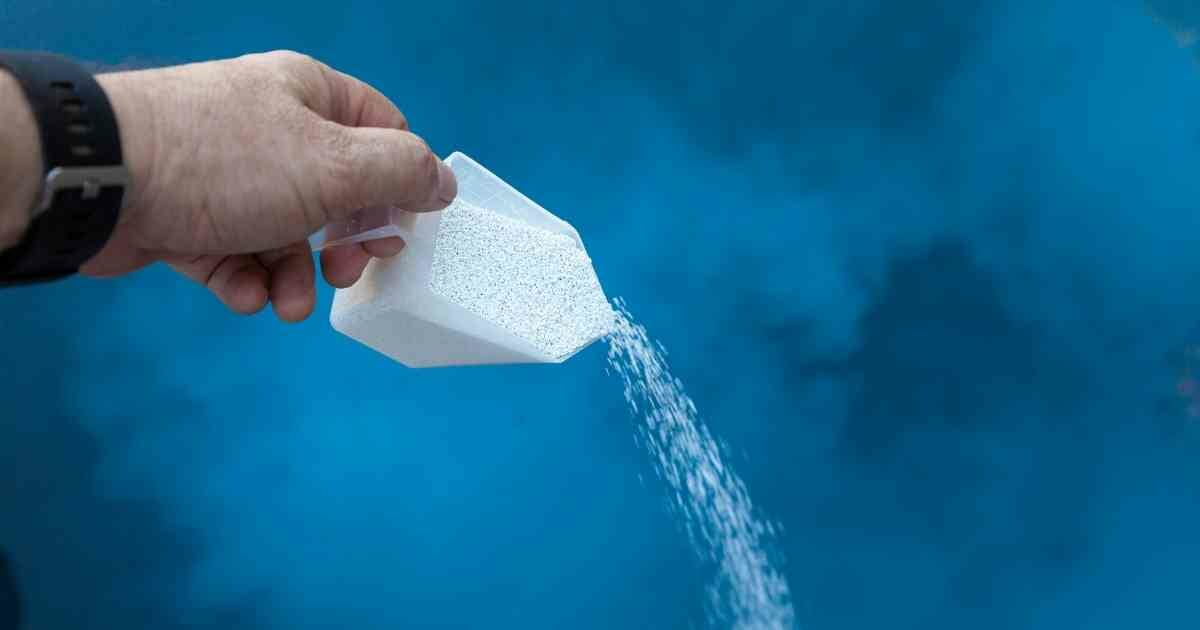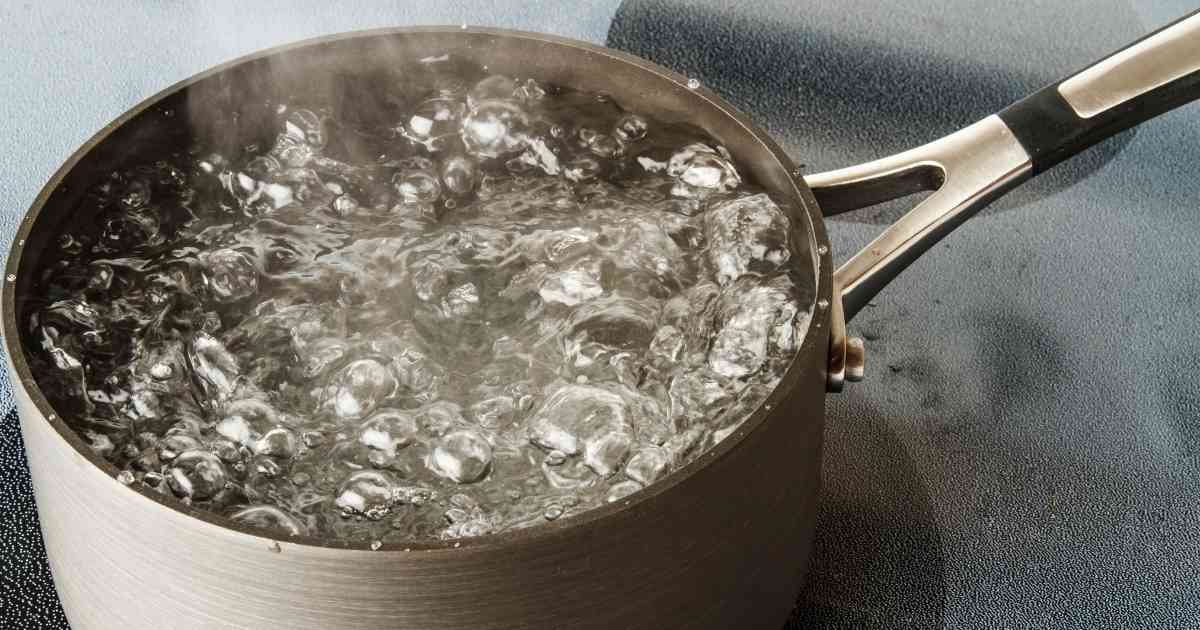We like to share product recommendations with you and hope you like them! Just to make you aware Water Filter Data may collect a small share of sales or other compensation from the links on this page.
Does boiling water remove chlorine? Very valid question! The answer is yes — boiling water does remove chlorine.
But is this the most effective and convenient method for purifying your tap water? We’ll answer this question and more further down in this post.
By the end of this article, you will know:
- What chlorine is and why it is added to your water supply
- what health risks are associated with chlorine in drinking water
- 5 different methods and several products (including UV light) for removing chlorine from your water
What Is Chlorine in Water?

We all know that smell. The smell of bleach, the smell of swimming pools, the smell that burns your nose. That’s chlorine. This chemical, also written as Cl, is a toxic gas at room temperature but can become a liquid if it is under the right amount of pressure.
It can irritate your skin and eyes and cause you to feel nauseous, but despite its downsides, it has some beneficial uses.
It is added to pools and water supplies to kill harmful bacteria, fungi, viruses, and parasites.
While this chemical does an excellent job of disinfecting water, it can be toxic to pet fish and other animals that live in or naturally spend a lot of time in water.
Because, unlike humans, these animals have skin that allows water to pass through and into their bloodstreams.
According to the CDC, 1 to 4 milligrams of chloramines per liter of water is safe for humans to drink. This is the standard for drinking water supplies in the U.S and other countries.
Is Drinking Chlorinated Water Harmful?
Drinking water that contains chlorine and chloramine can lead to health issues.
Researchers at Johns Hopkins recently found that adding chlorine to tap water supplies creates cancer-causing chemicals. They discovered these compounds in municipal water supplies in the United States.
Older studies have shown links between cancers in humans and the by-products of chlorinated water.
How Do You Remove Chlorine From Tap Water?
Besides the most obvious water purification method, water filtration, there are several other ways to turn your tap supply into clean, chlorine-free water. These include boiling, evaporation, and UV light.
Read on to find out which method best suits you.
Different Ways to Remove Chlorine
You can remove chlorine from your water using natural methods, chemical neutralizers, or filtration systems. Let’s take a look at the most effective filtration methods below.
Filtration Methods
Chances are that you have used a water filter before. Maybe it was the type that goes under a kitchen sink, or a pitcher filter, or even a Life Straw.
But did you know that all water filters don’t use the same filtration method?
Filter systems come in all shapes, sizes, and designs and use different filtration methods such as distillation, reverse osmosis, gravity, and activated carbon.
Distillation
The distillation process involves boiling water to produce steam in a controlled setting and collecting the droplets of pure water that condense in the machine.
Although distillers are mainly used commercially to make bottled water and alcoholic drinks, they are also available to consumers in user-friendly countertop sizes.
These convenient appliances take about 4 to 6 hours to produce 4 liters of pure water.
Reverse Osmosis
Like distillation, reverse osmosis is one of the most popular filtration methods used commercially.
In the RO process, the machines use pressure to force water molecules through a partially-permeable membrane.
Simply put, this means that the pores or holes in the filter membrane are big enough to allow only water molecules to pass through them. The other particles in the water are left behind.
You’ll typically find reverse osmosis systems under sinks in homes. This type of system usually takes two to four hours to make 10 liters of filtered water.
Gravity
Gravity-fed filters do not use power or electricity to work. Rather, they use the pull of gravity to separate water from other particles.
You might have made a simple gravity filter in science class using sand, stones, cotton, etc. It’s pretty much the same concept in consumer-grade gravity filters.
The water passes through several layers of membranes and materials such as ceramic and activated charcoal and comes out ready to drink in 2 to 4 hours (10 liters).
Activated Charcoal/ Carbon
Activated charcoal, also called activated carbon, is the product of heating natural materials like coconut husks and wood at very high temperatures in a controlled setting.
This highly porous material is used in filters in the form of blocks or small beads. These filters are very effective at removing contaminants like chlorine and heavy metals from tap water and getting rid of the bleachy odor and taste.
What’s even better is that activated carbon filters can churn our clean, crisp water in a matter of minutes, which makes them ideal for use in pitcher filters and faucet systems.
One thing to note is that different brands and models of carbon filter systems have different levels of effectiveness in removing chlorine and heavy metals. So it’s a good idea to read the specs of the filtration system before you buy it.
How to Remove Chlorine From Water Naturally
Other ways to naturally purify your chlorinated water include boiling, evaporation, and UV light filtration. Yes, UV rays can give you clean, chlorine-free water. How? Read on to find out!
Does Letting Water Sit Out Remove Chlorine?
Yes. Letting water sit uncovered in a container allows the chlorine to evaporate from it, given that the element is a gas at room temperature and is not very soluble in water to begin with.
How Long Should I Let Water Evaporate to Remove Chlorine?
In general, 24 hours is enough time to allow the chlorine to evaporate from four liters of water.
Of course, the amount of time also depends on the volume of water, the width of the container (a larger surface area is better), and the concentration of the chemical in the water.
Note that simply letting water stand will not remove chloramines. Boiling is not a very effective method of removing these chemicals either. The best way to rid your water of chloramines is through filtration.
UV Light Method
Ultra-violet light is the latest phenomenon in water filter technology.
It is another natural way of removing chlorine from your water, but it does a quicker job than the traditional methods. UV light can remove unwanted chemicals in a matter of seconds.
UV systems are usually more expensive but provide the whole house with clean water without all the fuss. Apart from being used by consumers, ultra-violet light is also used in industries like pharmaceuticals and wine-making.
How Does UV Light Remove Chlorine From Water?
Did you know that at certain wavelengths, UV light can change the structure of molecules?
When applied to water, these rays give the H2O molecules a jolt of energy that allows them to separate from the chlorine molecules. The chlorine then changes into a weak (harmless) acid in the water. This method is also effective at removing chloramines.
What Happens if You Boil Chlorine Water?

If you’re wondering if it would burst into flames, don’t worry, it won’t. Boiling chlorinated water will get rid of or significantly reduce the unwanted element.
How Long to Boil Water to Remove Chlorine
It can take about six to ten minutes to get the chlorine out of 45 liters (10 gal.) of water.
How Much Chlorine Does Boiling Remove?
Boiling for six to ten minutes can remove about 1 mg/L of chlorine from 45 liters of water.
Does Boiling Water in a Kettle Remove Chlorine?
Yes. It doesn’t really matter what medium you choose to boil your water in. As long as it’s boiling, chlorine is escaping from the H2O molecules and into the air.
Chemical Neutralizers
Campden tablets, also called potassium or sodium metabisulfite, are used to produce chlorine-free water.
Now, before you think that adding a chemical to remove a chemical doesn’t make sense, think of how baking soda reacts with vinegar to neutralize it without producing any harmful by-products. Well, that’s sort of how Campden tablets neutralize chlorine and chloramine.
They bind with these chemicals to form other compounds that are harmless to us in small amounts.
Campden is mainly used in wine and beer-making to sterilize beverage mixtures before they go through fermentation.
Besides these metabisulfites, vitamin C, a.k.a ascorbic acid, also neutralizes chlorine in tap water.
Let’s Recap
So, does boiling water remove chlorine? The answer is yes. But is boiling the best method? What’s your take?
What Is the Best Way to Remove Chlorine From Water?
Of all the methods we mentioned above, we find that water filters and UV light filters are the best options for removing chlorine and chloramine from water.
Not only are these methods quicker and more convenient than evaporation or boiling, but they also remove other contaminants from your drinking water.



